Critical Review: Analysing the "Malaska Move"
Click here to go back to the index page.
Introduction:
In this short review paper, I am going to critically analyse the "Malaska Move" as described by Mike Malaska in the following short golf intructional video.
Mike Malaska video - https://www.youtube.com/watch?v=1FvE9RbNaFY
I regard Mike Malaska's basic "pivot action" idea that
forms the foundational basis of the"Malaska Move" as being biomechanically and
mechanically problematic and I believe that teaching the "Malaska Move"
represents sub-optimal golf instructional teaching. I have produced a
critical video review of the "Malaska Move" type of golf swing action where I explain, and
demonstrate, why I think that the "Malaska Move" represents sub-optimal golf instructional
teaching, and I have posted that video to my you-tube channel.
Critical Review video: Analysis of the "Malaska Move" Golf Swing Action - https://youtu.be/8x4p1AqNnV8
In that 2 hour 14 minute video, I compare Mike Malaska's "Malaska Move" full
golf swing action to the TGM lead arm swinging action (based on an intact
LAFW/GFLW that is continuously "on-plane"), which I described in great detail in
my 7-hour video project (
http://perfectgolfswingreview.net/videoproject.html )
In this review paper, I will be providing supplementary information to bolster the many critical arguments that can be found in my critical review video. I will also briefly re-explain my critical arguments using a written prose format and I will supplement my critical arguments by using "evidence" from i) the golf swings of professional golfers and from ii) the results of golf research studies.
Analysing the "Malaska Move":
What is the "Malaska Move"?
I would advise all readers to first view the Mike Malaska video, so that they can see-and-hear an unedited explanation of the "Malaska Move" from Mike Malaska - before they read my following second-hand explanation (which is potentially biased).
Mike Malaska posed as follows at the start of his video.
Capture image from the Mike Malaska video.

Mike Malaska stated in his video that many golfers believe that they need to
pull the handle of the club downwards-and-forwards with their left hand at the
very start of the downswing so that they can try and get to this "alignment
position" at the P6 position (end of the mid-downswing position when the
clubshaft is parallel to the ground). Note that Mike Malaska's hands have
already reached a position that is close to the ball position (presuming that
the ball is placed somewhere between the left heel and the middle of the
stance), and that the back of his left hand (and therefore clubface) is facing
the ball-target line. Note that he still has ~90 degrees of clubhead lag. From
that position, he still has to release the club (via the release of PA#2) and he
also needs to square the clubface (via the release of PA#3) - see reference
number [1] for my personal interpretation of Homer Kelley's power accumulator
concepts. Mike Malaska
correctly states that it is very difficult (from a biomechanical and mechanical
perspective) to get the clubshaft to catch up to the straight left arm by impact
if the hands are already that far forward at the P6 position and he believes
that it will predispose a golfer to performing a rescue hand manipulation
maneuver (flip-rolling the club through impact). He also believes
that it is technically very difficult to square the clubface by impact by using
a late PA#3 release action (that only happens between P6.5 and
impact) and he believes that a golfer should rather start to rotate the left
arm/hand from the very start of the early downswing.
The most important part of Mike Malaska's video explanation relates to his description of the "pivot action". I routinely only use the term "pivot action" to describe the body motion (involving the sequential kinematic sequence of a counterclockwise pelvic rotary motion followed by a counterclockwise rotation of the upper torso with a variable degree of torso-pelvic separation) that happens during the downswing phase of the golf swing, but Mike Malaska uses the term "pivot action" to describe the motion of the clubshaft/clubhead as the clubhead moves from being behind the hands (between P4 and P6) to becoming in front of the hands (between P6 and impact). Mike Malaska seemingly uses the term "pivot point" as being the hand(s) position when the clubhead transitions from being behind-the-hands to becoming in front-of-the-hands and it usually happens towards the end of the mid-downswing (roughly in the time period between P5.5 and P6.25).
Here are a series of capture images showing how Mike Malaska demonstrates his "pivot action" (which is the primary motion that constitutes what I call the "Malaska Move").

Images 1 - 3 shows Mike Malaska demonstrating a single-arm drill used to ingrain
the motion of the "Malaska Move."
Image 1 shows Mike Malaska at the P5 position with his clubshaft being "on-plane" (where the butt end of the club points at the ball-target line). Note that his right palm is positioned parallel to the undersurface of the inclined plane, which means that his right forearm must be very supinated.
Image 2 shows the motion happening between P5 and P6. Note that Mike Malaska does not attempt to keep his clubshaft "on-plane" between P5 and P6 by pulling the butt end of the club in the general direction of the ball-target line - while keeping his right palm continuously parallel to the inclined plane (which usually becomes shallower in most professional golfers who transition from being roughly on the TSP at P4 to being roughly on the elbow plane by P6). Instead of pulling the handle of the club downwards-and-forwards in the general direction of the ball-target line (while maintaining a supinated right forearm), he concentrates his efforts on rotating his right forearm in a pronatory direction. That pronatory motion of his right forearm (which causes his right forearm to change from being supinated at P5 to being neutral by P5.5) causes the clubshaft to become much steeper and off-plane (where the butt end of his club points at his feet instead of pointing at the ball-target line). That clubshaft-steepening motion represents a *"tumble action" - a term coined by Brian Manzella.
(* See this short review paper - http://perfectgolfswingreview.net/VP7.html - for more information on a "tumble action" and to also read my personal explanatory reasons why a golfer should not routinely use a "tumble action" during his downswing action)
That biomechanical action seen in image 2 (primarily involving a right forearm pronatory motion) represents the start of Mike Malaska's "pivot action" where he intends to pivot the clubhead around the pivot point of his right hand so that the clubhead can move from being behind-his-right hand to being in front-of-his-right hand (image 3).
Note that he has completed his "pivot action" by P6.25 - P6.5 (image 3). Note that his right forearm is frankly pronated and that his right palm is facing the ground. Note that he is not moving his right hand forwards very much between image 2 and image 3 as he pivots the club from being behind-his hand to being in front-of-his-hand. Mike Malaska states in his video that the essential "feeling" of the "pivot action" must be a "feeling' of pulling the club handle backwards away from the ball-target line while simultaneously avoiding any forwards pulling of the club handle in the direction of the target - note how the butt end of the club pivots under his right forearm in image 3 and note how it points away from the target.
Here are face-on capture images showing the same "Malaska Move".
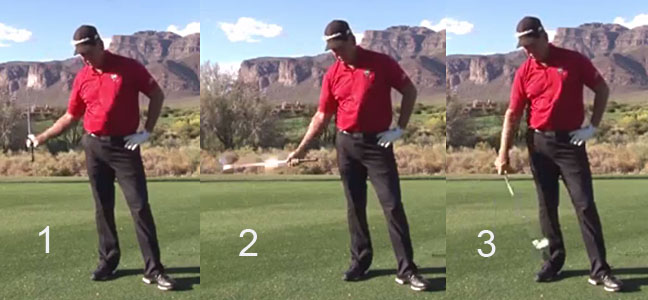
Image 1 shows Mike Malaska at the ~P5.5 position. Note that his clubshaft is
seemingly "on-plane" (where the butt end of the club points at the ball-target
line). Note that his right forearm is frankly supinated in image 1. In this
face-on presentation, he is not starting to pronate his right forearm at the P5
position, and he is delaying it to the P5.5 position.
Image 2 shows Mike Malaska performing his "pivot action" where he pronates his right forearm so that the clubshaft can "tumble" over-the-plane and bypass the pivot point of his right hand. Note his right hand does not move targetwards very much during his "pivot action". Note that his right palm has moved from being under the handle (in image 1) to being behind the handle (in image 2) as a result of that right forearm pronatory motion.
Image 3 shows the completion of the "Malaska Move" where the right forearm is frankly pronated to such a large degree that his right palm faces the ground. Note that his right hand has not moved targetwards during the time period between image 2 and image 3, and that he is rotating the handle of his club around his near-stationary pivot point so that the butt end of the club moves away from the target (and also moves backwards under the ventral surface of his right wrist, which is facing the ground).
It is important to understand that his personal video demonstration is only a drill designed to ingrain the "feeling" of rotating the right forearm in a pronatory direction so that it can "tumble" the clubhead over the pivot point and allow it to move from being behind-the-hands to being in front-of-his-hands. During the drill, he keeps his right hand relatively stationary at the pivot point, and he conceives of the club rotating around the pivot point during the transitional time period between the clubhead being behind-the-hands to then becoming in front-of-his-hands.
Mike Malaska states at the end of his video that when performing a "real life" golf swing, that the combination of using "two hands and body motion" during the later downswing will make it look more like the late downswing capture images often seen in videos of professional golfers.
Here are capture images of Mike Malaska demonstrating a full golf swing (which happens at the very end of his video) - where he performs the "Malaska Move" using two hands, while simultaneously performing the natural body motions usually performed during a professional-quality downswing action.

Mike Malaska is demonstrating the mid-late downswing action when "adding two
hands and body motion".
Image 1 is at the P5.5 position. Note that he has an intact LFFW and that his clubshaft is seemingly "on-plane" (where the butt end of the club points at the ball-target line). Note that his right palm is parallel to the undersurface of the inclined plane on which his intact LFFW lies, which biomechanically means that his right forearm must be frankly supinated.
Image 2 is at the P6 position. Note how he is pronating his right forearm so that it becomes more neutral by P6, and that causes his right palm to move from being under the club handle to being more behind and partly on-top of the club handle.
Image 3 is at a late downswing position. Note that he has over-pronated his right forearm to well beyond the neutral position, so that his right palm is partially facing groundwards. I think that his excessive/exaggerated right forearm pronatory motion (which is the foundational basis of the "Malaska Move") does not happen in professional golfers, and their right forearm pronates to a much smaller degree so that their right forearm rotates from being frankly supinated at P5.5 to become neutral by impact (where the right palm faces the target). However, at no time point during their mid-late downswing does their right palm face partially groundwards!
Consider an example of a professional golfer's late downswing action.
Henrik Stenson swing video - https://www.youtube.com/watch?v=adGkU1dAJkU
Capture images from the Henrik Stenson swing video.

Image 1 is at the P5.5 position. Note that he has an intact LFFW (see reference
number [2] for a definition/description of the LFFW) and note that
his clubshaft is seemingly "on-plane" (where the butt end of the club points at
the ball-target line). Note that his right palm is parallel to the undersurface
of the inclined plane on which his intact LFFW lies, which biomechanically means
that his right forearm must be frankly supinated. Note that the biomechanical
alignments of his right forearm/right palm are very similar to Mike Malaska's
right forearm/right palm alignments at his P5.5 position (see
image 1 above).
Image 2 is at the P6 position. Note that his right forearm is still frankly supinated, and that his right palm is still under the club's handle. Note that he is not pronating his right forearm very much - unlike what Mike Malaska recommends for his "Malaska Move" - and that his right palm is not rotating counterclockwise to a position that is more on top of the club's handle.
Image 3 is at the P6.5 position. Note that his club is releasing (representing the release of PA#2) between P5.5 and P6.5 and that causes his clubhead to move from being behind-his-hands at P5.5 to being in front-of-his-hands at P6.5. The club release action happens in the plane of his intact LFFW (plane of radial => ulnar deviation) and that there has been very little counterclockwise rotation of his intact LFFW between P6 and P6.5. Note that his right forearm has only pronated to a small degree between P6 and P6.5 and note that his right palm is still partially under the club, which means that he is not pronating his right forearm as much as Mike Malaska recommends for his "Malaska Move". Note that his two hands are moving targetwards to a significant degree, and that there has been very little counterclockwise rotation of the back of his left hand during this same time period.
Image 4 is at the P6.7 position. Note that he is now starting to release PA#3 (which is primarily due to a left forearm supinatory motion) while the club is still completing its final phase of his PA#2 release action. Note that his right forearm is rotating in a pronatory direction that causes his right palm to move from being under-the-club handle to being more behind-the-club handle - but note that his right palm never faces the ground.
Image 5 is at impact. Note that he has completed his PA#3 release action and that his right palm now faces the target. Note that his right forearm is neutral and not frankly pronated (as seen in Mike Malaska's full golf swing demonstration) and that his right palm never faces groundwards at any time point during the P5.5 => impact time period.
Mike Malaska in his video demonstrates what he believes to be the wrong approach - where he specifically states between the 2:10 minute and 2:20 minute time point of his video that one should not pull the club's handle forward while rotating the club.
Here are capture images of Mike Malaska's demonstration of what he perceives to be the "incorrect motion".
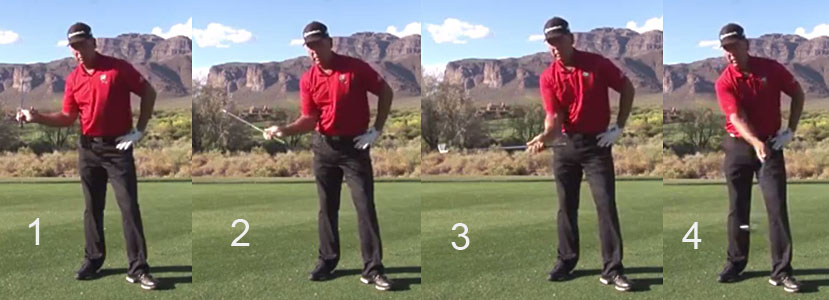
Image 1 is at the P5.25 position. Note that his clubshaft is roughly "on-plane" (where the butt end of the club points at the ball-target line). Note that his right forearm is frankly supinated and that his right palm faces skywards (because it is parallel to the undersurface of the inclined plane).
Image 2 is at the P5.5 position and image 3 is at the P6 position. Note that Mike Malaska is pulling his right hand forwards (like Henrik Stenson) but he is not rotating his right forearm in a pronatory direction (as happens in the "Malaska Move"). Note that the butt end of his club is pointing at the target (while it is parallel to the ball-target line) at P6 and he looks identical to Henrik Stenson at his P6 position.
Image 4 is at impact. Note that he continued to pull his right hand forward towards impact between P6 and impact, while simultaneously rotating his right forearm counterclockwise in a pronatory direction so that the right forearm can become neutral at impact with his right palm facing the target. That late downswing rotary motion of the clubshaft is exactly what Henrik Stenson (and most professional golfers) do in their late downswing. In other words, what Mike Malaska states is the "incorrect motion" is exactly the type of late downswing motion seen in most professional golfers.
I think that the "Malaska Move" makes no sense from a biomechanical/mechanical perspective. I do agree with Mike Malaska that a golfer (who wants to perform a golf downswing action like a PGA tour golfer) should not pull the club handle too much targetwards in a "handle-dragging" manner between P5.5 and impact because that will get the hands too far forward relative to the ball position by P6.5 and he will likely not have enough time to complete the release of PA#2, and then sequentially complete the release of PA#3, before impact - and that will result in an impact alignment scenario where there is i) too much forward shaft lean and ii) an open clubface, which will predispose to push-sliced golf shots. However, the correct golf instructional solution is not the band-aid "Malaska Move" (which will predispose to either a "tumble action" that will generate an out-to-in clubhead path through impact and/or an over-pronated right forearm that will likely predispose to a flip-rolling closing motion of the clubface through impact where the clubshaft also bypasses the straight left arm too soon after impact)! I think that the optimal biomechanical solution is to perform the downswing action like a professional golfer (eg. Henrik Stenson) and I will now describe the optimum downswing technique using Henrik Stenson's downswing action as an exemplary role model example for developing golfers.
Analysing Henrik Stenson's downswing action.
At the start of his video, Mike Malaska states a golfer should not start the
downswing by pulling the club handle forwards because that will
induce an early release of the club (early release of PA#2) and he states that a
golfer should start rotating the club at the very start of the downswing. I
agree with Mike Malaska that a golfer should not pull the butt end of the club
in a rounded arc manner downwards-and-forwards towards
the ball between P4 and P5.5 because that will induce an early club release
phenomenon (what Homer Kelley in his TGM book called a "sweep club release"
pattern). The left hand, and therefore the butt end of the club, should move in
relatively straight-line manner (with very little curvacture to the hand arc
path) in a mainly downwards direction between P4 and P5.5, so that the club only
starts to release at about the P5.5 time point (representing what Homer Kelley
in his TGM book called a "random club release" pattern).
However, I disagree with Mike Malaska that a golfer should start rotating the club (by performing a left forearm supinatory motion combined with a right forearm pronatory motion) from the very start of the downswing because that will predipose to a "tumble action". I believe that the intact LFFW should remain parallel to the inclined plane between P4 and P5.5 (even if the golfer is shallowing his clubshaft from the TSP at P4 to the elbow plane by P5.5) and I believe that there should be no left forearm supinatory motion (which is usually combined with a right forearm pronatory motion) between P4 and P5.5 because that will steepen the clubshaft and "tumble" it over the plane to an off-plane position where the butt end of the club points too far inside the ball-target line (as seen in image 2 of the "Malaska Move" demonstration).
Henrik Stenson swing video - https://www.youtube.com/watch?v=OKfe6F8PmUc
Here are capture images from the video showing how Henrik Stenson keeps his intact LFFW/GFLW parallel to the inclined plane between P4 and P5.5 while continuously maintaining an "on-plane" clubshaft during his clubshaft-shallowing action.
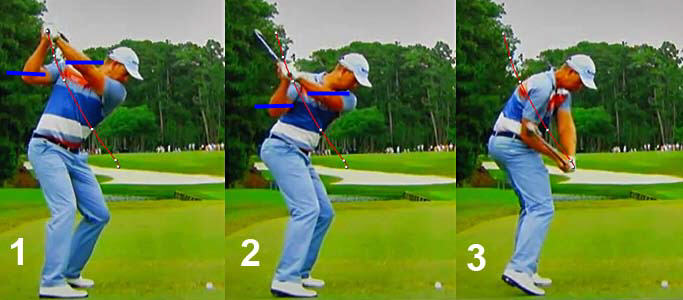
The red splined path represents his hand arc path. I have drawn short straight blue lines at the level of his two elbows to allow one to to assess the relative speed of "elbow dropping" of the two elbows between P4 (image 1) and P5 (image 2). An active right arm adduction maneuver will drop the right elbow groundwards fractionally faster than the left elbow and that will induce a clubshaft-shallowing phenomenon (note that the clubshaft shallows to a plane that is shallower than the plane of his hand arc path during his early-mid downswing).
Note that Henrik Stenson has his left hand and clubshaft on the TSP at his end-backswing P4 position (image 1), and that he shallows the clubshaft to the elbow plane by P5.5 (image 3). However, note that he keeps his clubshaft continuously "on-plane" (where the butt end of the club always points at the ball-target line) all the way between P4 and P5.5 and there is no clubshaft-steepening phenomenon due to a "tumble action" (which is biomechanically due to a left forearm supinatory motion combined with a right forearm pronatory motion). Note that he maintains an intact LFFW/GFLW all the way between P4 and P5.5 (even though his intact LFFW is shallowing out to the elbow plane during that time period) and that the back of his GFLW is always parallel to the inclined plane. Note that he specifically positions his RFFW during the P4 => P5.5 time period so that his right palm is always parallel to the undersurface of the inclined plane, and that means that his right forearm must be frankly supinated at P5.5 with his right palm facing skywards (and it must never become pronated so that his right palm faces groundwards).
What happens between the P5.5 and P6.5 position when Henrik Stenson's clubhead moves from being behind-his-hands to becoming in front-of-his-hands?
Here are capture images from the Henrik Stenson swing video showing what happens during the transition from the mid-downswing to the late downswing (with the P6 position being the inflection point that marks the transition from the mid-downswing to the late downswing, and the inflection point is nearly equivalent conceptually to Mike Malaska's "pivot point" term).
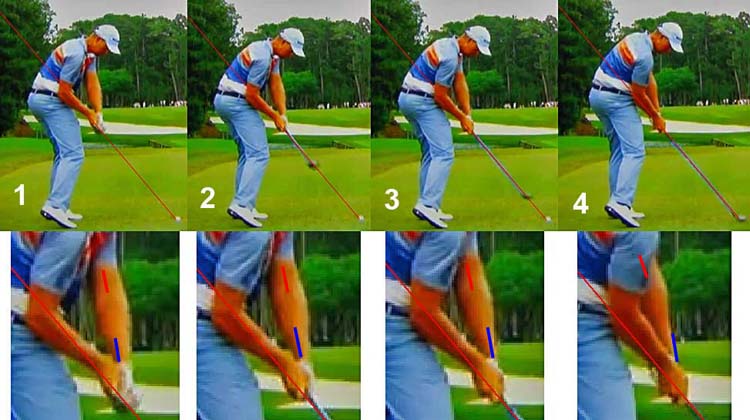
These capture images show what happens between P5.75 (image 1) and P6.5 (image 3). The red line represents the elbow plane, and one can note that Henrik Stenson's hands/clubshaft reaches the elbow plane by P5.75, and that his clubshaft stays on the elbow plane all the way between P5.75 and impact (image 4).
I have provided close-up images (below the top series of images) and I have drawn a short red line down the middle of his left antecubital fossa and a short blue line along his left forearm's lower radial bone just above the level of his left wrist.
Note that the back of his GFLW is parallel to the elbow plane at P5.75 and that his left forearm is slightly pronated (note that the blue line is slightly rotated clockwise relative to the red line). Note that his right forearm is frankly supinated at P5.75 and that his right palm is parallel to the elbow plane, and that it is positioned under-and-behind his club handle, which means that the right palm is facing partially skywards.
Image 2 is at P6.25. Note that his clubhead has bypassed his "pivot point" and that his clubhead (which was behind-his-hands at P5.75) is now in front-of-his hands. However, note that it happens secondary to the release of his club (PA#2 release action) and note that it is not due to a rotary motion of his left forearm in a supinatory direction (which would cause the blue line to move counterclockwise relative to the red line). Note that his right palm is now more behind the club's handle but still partially under the club's handle, and it is definitely not partially facing the ground (as happens in the "Malaska Move" secondary to excessive left forearm supination combined with excessive right forearm pronation).
Image 3 is at P6.5. Note that his left forearm is now starting to supinate faster, which causes the blue line to move counterclockwise relative to the red line. Note that his right palm is now more behind the club's handle, and it is now facing the target. In other words, his right forearm is moving from being frankly supinated at P5.75 to becoming more neutral by P6.5. Most importantly, note his right forearm is never frankly pronated at any time point between P5.75 and impact and his right palm never partially faces the ground (as seen in the "Malaska Move").
Most professional golfers who use a neutral left hand grip (like Henrik Stenson) have the same biomechanical actions happening during the transitional time period between the mid-downswing and the late downswing as the clubhead transitions from being behind-the-hands at P5.75 to becoming in-front-of-the-hands at P6.25 - and they do not perform the "Malaska Move" (which Mike Malaska wrongheadedly implies is a mandatory swing action in a professional-quality golf swing action).
Here is a graph from Phil Cheetham's research study (see reference number [3]) on the the 3-D motion analysis of 94 professional golfers, and it is very representative of what happens in a professional golfer who uses a weak or neutral left hand grip.
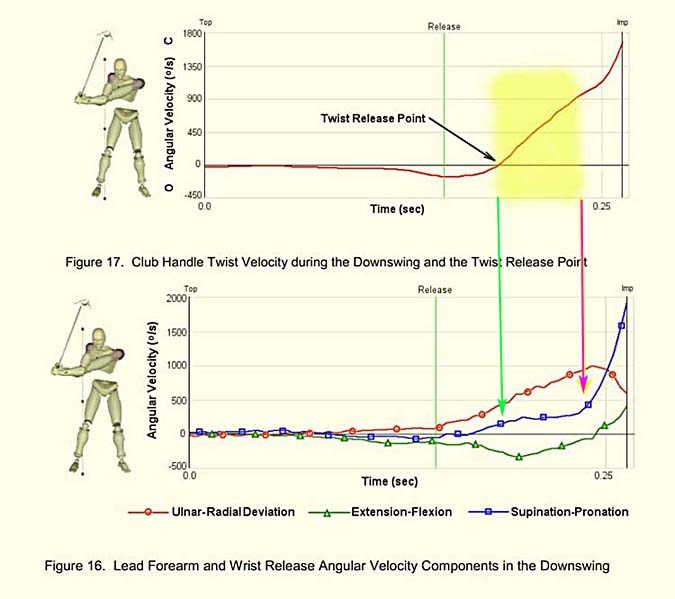
Phil Cheetham studied the handle twist velocity phenomenon happening during the downswing in 94 professional golfers.
The top red graph in figure 17 shows the club handle twist velocity during the downswing. Note that there is no counterclockwise twisting of the club handle during the early-mid downswing (from the top [P4 position] to the twist release point [which happens at about the P6 position]). In other words, professional golfers are not rotating their club handle during the early-mid downswing (as Mike Malaska incorrectly recommends). The vertical green line (labeled "Release") represents the start of the club release phenomenon (release of PA#2) - note that there is a significant time period between the PA#2 release point and the twist release point and during this time period the clubhead is moving from being behind-the-hands to being in front-of-the-hands. In other words, the clubhead pivots around the imaginary "pivot point" (Mike Malaska's term) due to the release of PA#2 and not due to a rotary motion of the forearms (as Mike Malaska incorrectly recommends).
The figure 16 graphs shows the biomechanical phenomena happening concurrently at the level of the lead forearm and lead wrist. The blue graph shows the velocity of left forearm supination happening after the twist release point. Note that there are two phases of left forearm supination-: i) a slow phase between the green vertical arrow and the violet vertical arrow and ii) a fast phase happening in the late downswing after the vertical violet arrow. Note that the speed of left forearm supination just prior to impact (in the late downswing phase after the vertical violet arrow) is very fast and it represents the release of PA#3, which is causally reponsible for squaring the clubface between ~P6.5 and impact. Note that the speed of left forearm supination is relatively slow during the time period between the twist release point and the violet vertical arrow and note that the club is releasing during this time period due to a left wrist uncocking action (in the direction of ulnar deviation as represented by the red graph). Note that the club release phenomenon is essentially completed by the time the golfer reaches the vertical violet arrow, and that the PA#3 release phenomenon essentially happens after completion of the release of PA#2. In other words, a golfer should not think of rotating his club handle very much between P5.5 and P6.5 using the "Malaska Move" if he wants to perform a golf swing like a professional golfer. During the time period between P5.5 and P6.5 the club is releasing (in the plane of the LFFW while the intact LFFW is rotating in a conical pendular manner) and the amount of left forearm supination (and therefore right forearm pronation) happening between P5.5 and P6.5 must just be enough to allow the releasing club to optimally perform a conical pendular motion that will keep the clubshaft continuously "on-plane" (where the clubhead end of the club continuously points at the ball-target line according to the fundamental TGM concept of "tracing a SPL" as visually demonstrated in reference number [4]). The "Malaska Move" (as demonstrated by Mike Malaska in his video) is fundamentally an off-plane motion that will make it impossible for a golfer to continuously remain "on-plane" during the P5.5 => P6.5 time period, and it is clear that it doesn't happen in a professional golfer's downswing.
The amount, and speed, of left forearm supination happening per unit time during the slow-and-rapid phase of the left forearm supinatory phenomenon depends on a number of factors - in particular, the angle of the left arm relative to the ground and the magnitude of the accumulator #3 angle during the PA#3 release action. Golfers who have a moderate-to-large accumulator #3 angle as they near impact will have more clubhead travel motion along the clubhead arc path per unit amount of roll motion of the club handle - compared to golfers who have a small accumulator #3 angle - and their clubhead path will therefore have a a different conical pendular shape. This is a complicated topic, and interested readers can view this short review paper - http://perfectgolfswingreview.net/VP6.html - if they want to better understand this topic. During the late downswing's right forearm paddlewheeling action, the right arm straightens at the level of the right elbow joint and the right forearm simultaneously pronates from being frankly supinated at P5.5 to eventually become neutral by impact, and the timing and speed of right forearm pronation must optimally be perfectly synchronised relative to the speed of left forearm supination so that the right forearm's pronatory motion can synergistically assist in the smooth release of PA#3 via the biomechanical mechanism of push-pressure being applied by the base of the right palm over the left thumb's metacarpal area at PP#1. The exaggerated right forearm pronatory motion happening during a "Malaska Move" will make it far more difficult to use the right forearm in the correct manner during the late downswing so that it can synergistically assist in the optimum biomechanical release of PA#3.
I can readily imagine that Mike Malaska is TGM-illiterate and I strongly suspect that he doesn't understand the primary role of the RFFW in a TGM swinger's action (which is the swing technique used by the majority of PGA tour golfers). He seemingly doesn't undertand that the primary role of the RFFW in the early-mid downswing is to support the intact LFFW as it descends down the inclined plane between P4 and P5.5, which means that the right forearm must always remain supinated so that the right palm always remains parallel to the inclined plane. Between P5.5 and impact, the intact LFFW has to rotate counterclockwise so that the back of the GFLW can face the target by impact, and the amount of roll of the intact LFFW happening during that time period is inversely proportional to the strength of the left hand grip - being greatest in golfers who adopt a weak-neutral left hand grip. During that time period of counterclockwise roll motion of the intact LFFW - during which time period the club is continuously releasing within the plane of the intact LFFW - the right forearm has to pronate so that the right palm can continuously remain parallel to the rotating plane of the intact LAFW, which is continuously rolling in a counterclockwise direction. Any push-pressure being applied by the base of the right palm at PP#1 (which is above the coupling point) as a result of the right forearm paddlewheeling action (involving the combination of a "right arm straightening motion + right forearm pronatory motion") must only be enough to synergistically assist in controlling the speed of rotation of the intact LFFW/GFLW so that the clubface can become square by impact. I discussed this issue between the 26:00 minute and the 34:30 minute time point of the part 6 video from my video project on "How to Perform a Golf Swing Like a PGA Tour Golfer" ( https://www.youtube.com/watch?v=wcl4pNxgl5U&t=2076s )
Here are capture images from my part 6 video.
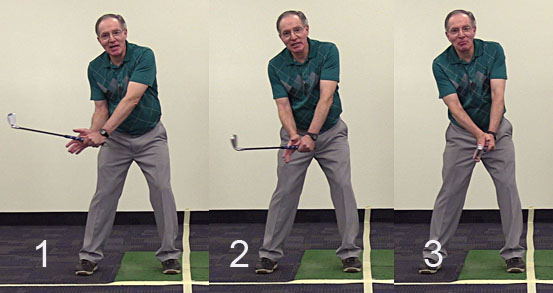
I (author) am demonstrating (using a short, child-size golf club) how the right palm applies push-pressure against PP#1 during the right forearm's paddlewheeling action between P6 (image 1) and impact (image 3). I am deliberately opening the fingers of my right hand to allow a viewer to note how it is the base of the right palm that is applying push-pressure against the base of the left thumb at PP#1 during the right forearm's paddlewheeling action (Homer Kelley's term for descrbing the motion of the right forearm during the late downswing).
Image 1 is at the P6 position. Note that the back of my GFLW is parallel to the inclined plane and ball-target line. Note that the clubface is straight-in-line with my GFLW and watchface area of my left lower forearm - because I use a neutral left hand grip and because I have an intact LFFW and a GFLW. Note that my right elbow is in a pitch location near my right hip area. Note that my right elbow is still fully bent. Note that my right forearm is frankly supinated so that my right palm can be parallel to my intact LFFW/GFLW.
Image 2 shows how my intact LFFW/GFLW rotates counterclockwise due to a left forearm supinatory motion. Note that my right elbow is straightening and that my right forearm is pronating towards becoming less supinated and increasingly neutral. Note that the amount of right forearm pronation happening per unit time is just enough to keep the right palm continuously parallel to the intact LFFW/GFLW and one can imagine that the right palm can be continuously applying push-pressure against PP#1 to synergistically assist in the smooth counterclockwise rotation of the intact LFFW/GFLW unit.
Image 3 is at impact where the back of my GFLW, watchface area of my left lower forearm and clubface face the target. Note that my right palm also faces the target and that my right forearm is neutral (and not frankly pronated). Note that my right elbow is still slightly bent and that my right wrist is still dorsiflexed.
At no time point during the late downswing does the right palm ever face partially groundwards (as seen in the "Malaska Move").
I would highly recommend that interested readers view my
entire video project (
http://perfectgolfswingreview.net/videoproject.html ) if they want to better
understand how to play golf with an intact LAFW/GFLW and a supporting RFFW. Once
a golfer understands the principles of an intact LAFW and supporting RFFW, then
he will better understand why the "Malaska Move" concept is such a
biomechanically, and mechanically, sub-optimal idea.
Jeff Mann.
June 2017.
References:
1. Describing my personal interpretation of Homer Kelley's power accumulator
concept, and and describing which power accumulators are used to power the golf
swing in a PGA tour golfer who uses a TGM swinging technique.
Available at http://perfectgolfswingreview.net/VP10.html
2. Difference between a left arm flying wedge (LAFW) and a left forearm flying
wedge (LFFW).
Available at http://perfectgolfswingreview.net/VP5.html
3. Phil Cheetham's PhD dissertation paper.
Available at http://www.philcheetham.com/phd-dissertation-and-presentation
3a. Cheetham P. (2014) The relationship of club handle twist velocity to selected biomechanical characteristics of the golf drive. Doctoral dissertation. http://www.philcheetham.com/media/Phillip-Cheetham-Doctoral-Dissertation-2014.pdf
3b. Phil Cheetham's Powerpoint Presentation in Defense of his PhD Dissertation.
http://www.philcheetham.com/media/Phillip-Cheetham-Dissertation-Powerpoint-2014.pdf
4. How to learn how to trace the straight plane line
(SPL) of the ball-target line using a Smartstick laser device - watch the
following video (
https://www.youtube.com/watch?v=wJveJDoNzCw ) between the 8:24 minute time
point and the 13:30 minute time point.